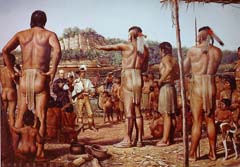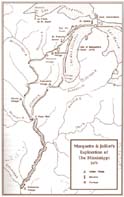
 |
Arrival of Marquette and Jolliet at the Grand Village of the Kaskaskia, 1673. (painting by Robert A. Thom, 1967) |
One can scarcely understand [the Illinois language], although it is somewhat like the Algonquin; still I hope, by the Grace of God, to understand and be understood, if God in his goodness lead[s] me to that Country. (Jacques Marquette, 1669)![]()
Left: Map of Marquette and Jolliet's exploration of the Mississippi River, 1673.
![]()
Jacques Marquette's opportunity to visit the Illinois finally arose in 1673, when he accompanied Louis Jolliet, a young Canadian fur trader, on an expedition to explore the Mississippi River. This venture was ordered by Count Frontenac, Governor of New France, who, like many before him, sought a Northwest Passage across the North American continent to the Orient.
enlarge map
Marquette and Jolliet set out from the Mackinac Straits in May, 1673, with five boatmen in two birchbark canoes. They paddled down Lake Michigan into Green Bay, portaged between the Fox and Wisconsin rivers, and slipped into the broad Mississippi River. On their trip down the Mississippi they saw beautiful islands, prairies, and forests inhabited by deer, bison, wildcats, and turkeys. The river itself contained geese, swans, sturgeons, and "monstrous" fish. However, for eight days they saw no traces of people.
Then, on June 25th, they found human footprints on shore and a path that led across a prairie. Following the path, they discovered three Indian villages located near the Des Moines River in what is today northeast Missouri. Four men slowly approached them from one of the villages. Two carried large smoking pipes, called calumets, which were finely ornamented and adorned with feathers.
I . . . asked them who they were. They replied that they were Ilinois; and, as a token of peace, they offered us their pipes to smoke. (Jacques Marquette, 1674)![]()
The explorers held council with the "great Captain" or chief of the Illinois, where they smoked the chief's calumet, exchanged gifts, made speeches, and feasted on servings of corn, fish, and bison. The chief's village consisted of 300 lodges and was called "pe8area" or "peouarea" (Peoria).
After departing the Peoria village, Marquette and Jolliet proceeded down the Mississippi to the mouth of the Arkansas River before they reversed their course and returned to the Great Lakes via the Illinois River. They learned of two more Illinois villages on this part of the voyage: a Michigamea village that they heard about, but did not visit, in northeastern Arkansas, and a Kaskaskia village that they visited while ascending the Illinois River in north-central Illinois.
We found on [the Illinois River] a village of Ilinois called Kaskasia, consisting of 74 Cabins. They received us very well. (Jacques Marquette, 1674)![]()
The 74 cabins Marquette counted in this village, which became known as the "Grand Village of the Kaskaskia," may have represented a total population of about 1,500 people. Before leaving the village he promised to return and provide religious instruction to the tribe. Although his health was failing at the time, Marquette did return in the spring of 1675. In anticipation, the village had swelled to perhaps five times its original size to include a number of different Illinois tribes. Marquette spoke to a council of more than 1,500 chiefs, elders, and young men, who formed a great circle around him on a "beautiful prairie" adorned with reed mats and bearskins.
Marquette died soon after establishing his mission at the Kaskaskia village, but his death did not end the French connection with the Illinois Indians. Rather, a long succession of priests and fur traders trickled into the Illinois Country. The priests wished to convert the Illinois to Christianity. The traders wanted to build a profitable commercial empire based on bison hides, beaver pelts, and other natural resources of the vast Mississippi River valley. For example, Father Claude Allouez took charge of Marquette's mission in the late 1670s. And, in 1679, two men--René-Robert Cavelier, Sieur de La Salle, and Henry de Tonty--began an ambitious campaign of exploration and commerce in the region.![]()
|
|
Copyright © 2000 Illinois State Museum
